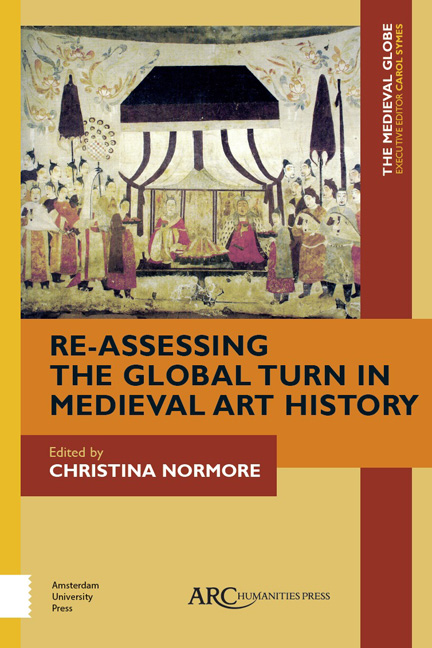Book contents
- Frontmatter
- Contents
- List of Illustrations
- Editor’s Introduction: A World within Worlds? Reassessing the Global Turn in Medieval Art History
- A Camel’s Pace: A Cautionary Global
- The Fatimid Holy City: Rebuilding Jerusalem in the Eleventh Century
- Worldliness in Byzantium and Beyond: Reassessing the Visual Networks of Barlaam and Ioasaph
- Exchange of Sacrifices: West Africa in the Medieval World of Goods
- The Beryozovo Cup: A Byzantine Object at the Crossroads of TwelfthCentury Eurasia
- Mobile Meanings: A Global Approach to a Dagger from Greater Syria
- Global Medieval at the “End of the Silk Road,” circa 756 CE: The Shōsō-in Collection in Japan
- Response: Medievalists and Early Modernists—A World Divided?
- Index
The Fatimid Holy City: Rebuilding Jerusalem in the Eleventh Century
Published online by Cambridge University Press: 23 January 2021
- Frontmatter
- Contents
- List of Illustrations
- Editor’s Introduction: A World within Worlds? Reassessing the Global Turn in Medieval Art History
- A Camel’s Pace: A Cautionary Global
- The Fatimid Holy City: Rebuilding Jerusalem in the Eleventh Century
- Worldliness in Byzantium and Beyond: Reassessing the Visual Networks of Barlaam and Ioasaph
- Exchange of Sacrifices: West Africa in the Medieval World of Goods
- The Beryozovo Cup: A Byzantine Object at the Crossroads of TwelfthCentury Eurasia
- Mobile Meanings: A Global Approach to a Dagger from Greater Syria
- Global Medieval at the “End of the Silk Road,” circa 756 CE: The Shōsō-in Collection in Japan
- Response: Medievalists and Early Modernists—A World Divided?
- Index
Summary
MEDIEVAL JERUSALEM WAS a city of contact, conflict, and change. Its globalism was characterized by a confluence of Christian, Muslim, and Jewish populations within the city and in the movement of people from the eastern Roman Empire (Byzantium), the Islamic world, and Latin Christendom. Architecturally, the monuments of the Haram alSharif stand as some of the most iconic structures in the history of Islamic art. Scholarly analysis of Islamic Jerusalem often focuses on the monuments of the Haram alSharif (known as the Temple Mount to Jews and Christians) at the time of its foundation, under the Umayyad caliphate (661– 750 CE). However, the Umayyads only controlled the city for a little more than fifty years after their construction of the Dome of the Rock (completed in 691/ 2).
In contrast, many of the preCrusader monuments on the Haram alSharif were renovated and rebuilt under the patronage of the Ismaili Fatimid dynasty (909– 1171). This essay explores the architectural history of Jerusalem in the period after the Umayyads and before the Crusades. With a focus on the interrelationship among confessional groups in Jerusalem and their identification with sacred space, it examines the transformation of the city in the Abbasid and Fatimid eras. In particular, the renovations to the Haram alSharif under the Fatimid caliph alZahir (r. 1021– 1036) brought increased prominence and renewed building projects on the Haram alSharif, in marked contrast to the treatment of the city by the Abbasid rulers. This analysis of changes to and conflicts surrounding sacred, confessional space illuminates global and local dynamics in architectural patronage patterns.
Compared to the time of the Umayyads, Abbasidera Jerusalem was characterized by a caliphal disinterest in the monuments of the holy city. However, it also saw growth in the identification between local populations and their respective religious monuments. This contest over sacred space culminated under the Fatimid dynasty, in the cataclysmic reign of alHakim biAmr Allah (r. 985– 1021), who is infamous today because he called for the destruction of the Holy Sepulchre. Indeed, alHakim's incursion into the city was predominantly destructive.
- Type
- Chapter
- Information
- Re-Assessing the Global Turn in Medieval Art History , pp. 35 - 56Publisher: Amsterdam University PressPrint publication year: 2018



